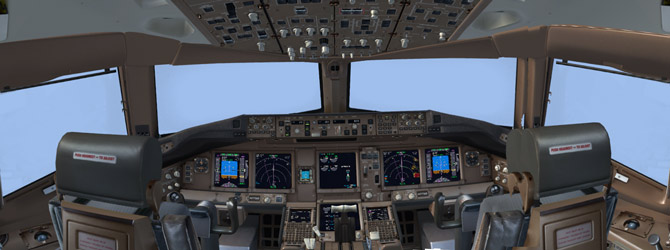
I’d like to consider myself a man with a strong stomach. I bungee jump. I used to ski competitively, and had a ton of fun doing flips in the terrain park. Roller coasters are a personal favourite of mine, and spinning around a baseball bat before clubbing what you had hoped to be the spider-man piñata, but really turned out to be your sister (that was the best).
And we’re all simmers who love a challenge. We all crank up (or down?) the visibility on our flights to reflect that 5-days-a-year 1/4 mile (400m) visibility in fog, (then curse the AI traffic engine when 12 aircraft try to land in 9 seconds and all go-around, except for the moron taxiing way to slowly to an exit off the runway).
We do it because it forces us to fly by our gauges, trusting in the instruments and in the fail-safes, yet ready to do the missed approach if something goes awry. Flying in ugly IMC conditions, to the minimums, truly is the pinnacle of IFR flight.
But there’s a level of disconnect between us and the reality of IMC that not all simmers are aware of – something that truly puts all our faith in the gauges in a way that steady-state peripheral vision just can’t simulate.
IMC Throws Your Visual Senses Out the Door
Seeing is 80% of interpreting our surroundings, some studies say. Having flown in IMC, I believe it. Aviators real and virtual have an opportunity that nobody else can really get, which is to completely and utterly disorient yourself to the point where “up” is provided by interpretation of 3 colors: Blue, Brown, and a stick (or chevron) of Orange (which changes to white or yellow when planes get bigger).
I’m talking about that Attitude Indicator, or Artificial Horizon (hereafter called the AI). Most of us in the sim world, I assume, actually start to ignore the indications it gives, instead we focus solely on the two little lines (or one chevron) of the Flight Director. I mean, why not? It’s easy. Brainless.
Brainless Flying?
That’s not really something we want as pilots striving for safety. The attitude indicator is essential, of course, but for a challenge, fly your flight without it. It makes things much harder, because the “Needle/Glideslope/Localizer Alive” calls start to be far more important, and you get to time your intercepting turn.
But back to the point – the disorientation of IMC. So maybe your Flight Director failed, maybe it didn’t. Hopefully not, but either way, when all you have to tell you which way is up is the AI, your head starts going for a spin, at least the first few times you do it. Toss in some turbulence and it’s even trickier.
What I’m trying to get at is that this is that this is something that is achievable in flight simulator, and serves a very important purpose in IFR. Trusting in your gauges. Believing in them, and doing so almost blindly – there is redundancy in most modern cockpit that allows for both pilots to trust their gauges, and cross-reference them for integrity, but that’s a topic for another time.
So what needs to happen for you to understand the disorientation of IMC and the challenges that comes with it is this:
1. You need proper gear: Yoke/Stick, and pedals as a minimum, a throttle if you can (we need to get your feet off the ground and your hands off your chair)
2. You need a respectably-sized screen, or several screens. More screens will help immensely.

3. You need a way to visually isolate yourself from the room around you. All your eyes should see are the screens, and the controls. If you see ceiling or walls, this won’t work. This can be acheived by either physically building a box in which your simulator will sit, or by wearing an IFR hood.
The IFR hood remains the most effective way of disconnecting your visual reference to the earth.
What will this do?
Well, it will (or should) throw your stomach a little upside down if you try to fly any aircraft without the autopilot. And now, SKILL will develop. You will get better feel for your plane, you will understand what it going on with your plane even more.
And to you VFR pilots out there who say “But you can’t feel the plane in a simulator!” I say this to you:
The only thing you can trust in IMC is your instrumentation.
Not your senses – they’ll lie to you. You might be inverted, pulling some bizarre positive-G maneuver, and your inner ear will tell you “this is ok”, your eyes will tell you “All I see is white, I dunno which way is up”, and your bum is telling you that you’re in a gentle climb.
Your AI would be wishing it had a hand to smack you with to set you straight. Because it is right.
And heck, you should be cross-referencing your other gauges too, because chances are if you’re inverted pulling positive G’s, your altitude is probably. plummeting.
So, disconnect yourself. Be happy that your Flightsim rig, no matter how simple or complicated it is, is suitable for IMC flight if your isolate yourself from everything but your screens. And try flying that approach again, this time with your head spinning (at this point it it very well should be).
If you can’t do it, you need to practice it, because this isn’t something you can do a checklist for and solve. If your autopilot fails, you need to fly that plane, no matter the conditions. VMC is what you take your frail grandmother up in. IMC kills.
This article was posted in Blog, Flight Simulator, Flightsim Tips, Human Factors, IFR Flight, Real World
Please note: We reserve the right to delete comments that are snarky, offensive, or off-topic. If in doubt, read the Comments Policy.

